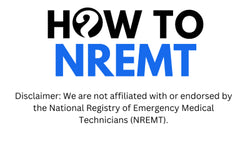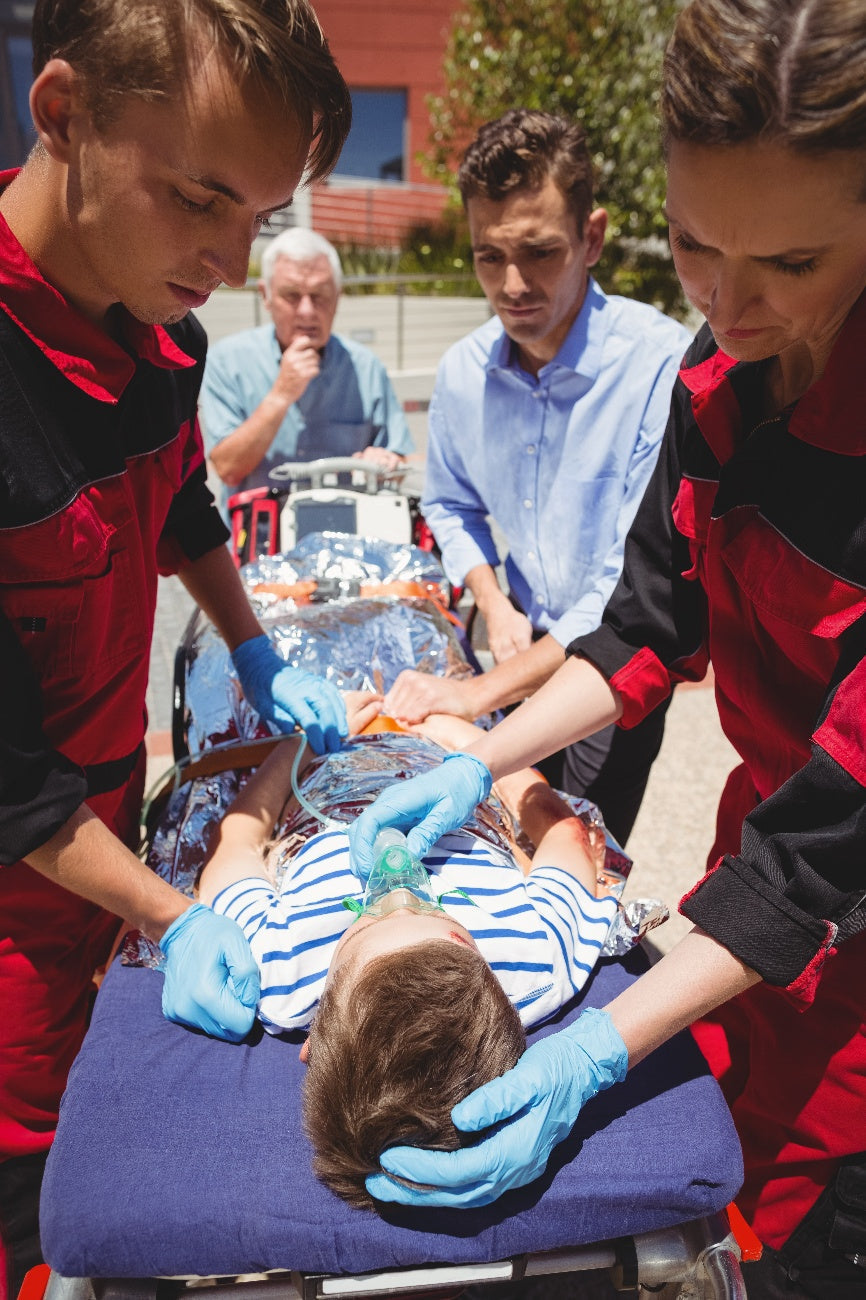Whether you’re aiming for EMT, AEMT, or Paramedic certification, one thing is clear—pediatric care is no longer a side topic. It’s a core focus of today’s NREMT exam. With an increased number of pediatric EMT questions showing up across domains like Airway, Medical, and Patient Care, it’s critical that test-takers know what to expect and how to respond with confidence.
This blog breaks down how pediatric topics appear on the NREMT cognitive exam, what content areas they fall under, and how to build targeted study habits that ensure you’re ready for anything—whether it’s a feverish infant or a multi-system trauma in a school-age child.
Where Pediatric Questions Show Up on the Exam
If you’ve been reviewing the NREMT’s updated content domains, you may have noticed a subtle but important shift—pediatrics is woven throughout nearly every section, not siloed in a standalone category. This means that whether you’re answering trauma scenarios or airway management questions, pediatric-specific knowledge could be tested.
Here’s how pediatric EMT questions are typically distributed:
1. Airway, Respiration & Ventilation
Pediatric airway scenarios are often more complex than adult cases. Infants and toddlers have smaller airways, higher respiratory rates, and a greater risk of obstruction. Expect questions on:
·Pediatric respiratory distress vs. failure
·Proper BVM sizing and technique
·Use of airway adjuncts like NPAs and OPAs in children
·Identifying upper vs. lower airway obstruction in pediatrics
2. Cardiology & Resuscitation
Cardiac arrest in children often stems from respiratory failure or trauma—not cardiac origin like in adults. You’ll need to know:
·Compression-to-ventilation ratios for infants and children
·Pediatric AED pad placement
·How to modify CPR steps by age group
·Signs of compensated vs. decompensated shock
3. Medical & Obstetrics/Gynecology
From febrile seizures to allergic reactions, pediatric medical emergencies test your ability to triage symptoms and apply age-appropriate care. You may be asked about:
·Pediatric Assessment Triangle (PAT)
·Treatment priorities for common childhood illnesses
·Managing pediatric anaphylaxis or dehydration
·Safe medication dosing in pediatric patients
4. Trauma
Pediatric trauma questions challenge your understanding of anatomical differences and emotional presentation. Be ready to answer:
·How to immobilize a pediatric spinal injury
·Recognizing signs of child abuse (non-accidental trauma)
·Head trauma in infants vs. older children
·Bleeding control techniques in pediatric patients
5. EMS Operations
Even operational domains include pediatric angles—like how to safely transport a neonate, or what to document in suspected abuse cases. Expect real-world judgment scenarios here, especially involving scene safety and mandated reporting.
Key Takeaway:You won’t see a section labeled “Pediatrics” on your test—but pediatric EMT questions are everywhere. Preparing across all five domains with pediatric variations in mind is essential for passing the NREMT cognitive exam on the first try.
Why Pediatric Scenarios Are So Challenging (Even for Experienced EMTs)
It’s no secret—even seasoned EMTs feel a surge of pressure when treating pediatric patients. In real-world EMS and on the NREMT, pediatric scenarios require a unique combination of clinical skill, emotional awareness, and rapid judgment.
So what makes pediatric EMT questions especially difficult on the exam?
1. Less Field Exposure
Many EMS providers go weeks—or months—without encountering a pediatric call. That lack of regular hands-on exposure means fewer reference points when you’re answering pediatric-focused questions on the NREMT. For many test-takers, these feel like high-stakes hypotheticals rather than scenarios they’ve personally worked through.
2. Emotional Weight
The emotional stakes are always higher with pediatric patients. Whether you’re dealing with a choking toddler or a trauma call involving an infant, test scenarios often tap into the responder’s instincts. On the exam, this can cause hesitation or second-guessing—even if you know the correct protocol.
3. Pediatric Anatomy Is Not Just “Smaller”
Children aren’t just tiny adults. Their airway structures, blood volumes, and vital signs follow completely different baselines. For instance:
·A normal heart rate for a 6-month-old may signal shock in an adult
·Small changes in fluid loss can have a major systemic impact
·Airway obstruction can escalate in seconds due to a narrower trachea
Without consistent review, it’s easy to misread a question or choose an adult-based intervention that would be harmful in pediatric care.
4. Situational Judgment Is Tested
The NREMT cognitive exam often presents pediatric questions with emotional distractions or parent presence. You might be asked what to do first in a high-stress situation involving an unconscious child, or how to prioritize interventions when multiple family members are present. These questions aren’t just about facts—they’re about judgment.
Pro Tip: Pair your content review with scenario-based NREMT exam practice to feel confident answering pediatric EMT questions. The more you simulate real-world distractions and triage situations, the better your decision-making under pressure.
How Pediatric EMT Questions Are Weighted by Domain
Pediatric questions don’t exist in a vacuum—they’re integrated across all five content domains of the NREMT cognitive exam. While the National Registry doesn’t publish exact percentages, we know from exam guidance and feedback that pediatric scenarios make up a significant portion of the questions you’ll face, especially in entry-level (EMT and AEMT) exams.
Here’s how they typically show up in each domain:
1. Airway, Respiration & Ventilation (18–22%)
·Pediatric-specific airway techniques (e.g., jaw thrust in infants)
·Proper ventilation with age-appropriate rates and devices
·Recognizing early respiratory distress in neonates and children
Expect at least a few pediatric airway scenarios—particularly involving respiratory failure, which is a leading cause of pediatric cardiac arrest.
2. Cardiology & Resuscitation (20–24%)
·Pediatric BLS/CPR sequences and modifications
·Age-specific vital sign interpretation
·AED pad placement and rhythm recognition in children
You may encounter pediatric cardiac questions that test both algorithm recall and scene judgment (e.g., “What’s your next action if…”).
3. Trauma (13–17%)
·Pediatric immobilization techniques
·Blunt vs. penetrating trauma in school-aged children
·Signs of internal bleeding in nonverbal or preverbal patients
Pediatric trauma questions often require anatomical awareness (larger heads, more flexible bones) and emotional composure.
4. Medical/OB-GYN (27–31%)
·Febrile seizures, anaphylaxis, and dehydration
·Newborn care, including APGAR scoring and suctioning
·Pediatric medication dosing and delivery
This is the most heavily weighted section, so you can count on a range of pediatric EMT questions here—from subtle symptoms to life-threatening conditions.
5. EMS Operations (10–14%)
·Legal and ethical considerations (e.g., suspected child abuse)
·Pediatric transport and documentation
·Use of pediatric restraint systems
These questions may feel more logistical, but they’re still high-stakes—especially in terms of mandated reporting and safe transport.
What This Means for You
Don’t treat pediatrics as an optional review. Across every domain, you’ll encounter pediatric scenarios that challenge both your technical skills and clinical judgment. This is where tools like a trusted NREMT prep tutor or structured NREMT prep course can help you focus your study time on the most tested areas.

Top Pediatric Topics to Master Before Test Day
You don’t need to memorize an entire pediatric textbook to pass the NREMT—but you do need to master the specific topics most likely to appear. These aren’t random facts. They’re high-frequency clinical themes the NREMT uses to assess whether you’re ready to treat real children in the field.
Here are the core pediatric topics every test-taker should focus on:
1. Pediatric Assessment Triangle (PAT)
This quick visual assessment tool is one of the most frequently tested frameworks. You’ll need to recognize signs of instability by observing:
·Appearance (muscle tone, eye contact, cry)
·Work of breathing (retractions, nasal flaring)
·Circulation to skin (color, mottling, cap refill)
The PAT doesn’t replace vitals—it helps prioritize interventions quickly in the field and on your test.
2. Airway and Ventilation Techniques
Questions will test your knowledge of:
·BVM sizing and technique for neonates, infants, and toddlers
·When and how to use airway adjuncts
·Correct ventilation rates for each age group
·Positioning for airway patency in infants (e.g., towel under shoulders)
Understanding airway differences is critical—small errors can cause big consequences in pediatric care.
3. Pediatric Vital Signs by Age
You must know what’s normal vs. alarming in terms of:
·Heart rate
·Respiratory rate
·Blood pressure
·Skin signs
Expect questions where you’ll need to interpret vital signs in context, like recognizing compensated vs. decompensated shock in a febrile 3-year-old.
4. Seizures and Febrile Seizures
This is one of the most common medical emergencies in children—and a frequent test topic. Know how to:
·Differentiate between seizure types
·Ensure scene safety
·Manage the airway and provide supportive care
·Educate caregivers post-event (if included in scenario)
5. Pediatric CPR
High-yield facts to memorize:
·Compression depth and rate
·Hand positioning by age
·Ratio of compressions to ventilations (solo vs. team)
·AED use with pediatric pads or adult pads (if child-specific pads unavailable)
You might get standalone CPR questions or ones embedded in longer trauma/resuscitation scenarios.
6. Child Abuse and Mandated Reporting
Ethical and legal knowledge is tested just as much as clinical skill. Be ready to identify red flags (inconsistent stories, bruising in non-mobile infants) and know:
·Your obligation to report
·What constitutes reasonable suspicion
·How to document appropriately
7. Medication Dosing and Delivery
Pediatric med questions often appear as multi-step calculations. Be comfortable with:
·Weight-based dosing
·Use of Broselow tape or age-based formulas
·Recognizing overdose risks
·Proper routes of administration (e.g., rectal diazepam, intranasal epinephrine)
Study Smart, Not Broad
Instead of trying to master everything, focus your pediatric prep on these high-yield topics using targeted resources like practice NREMT test platforms and an experienced EMT tutor. This focused approach can help you retain what matters—and pass confidently on test day.
How to Practice Pediatric Scenarios Effectively
Knowing pediatric facts is one thing—applying them under pressure is another. The best way to prepare for pediatric EMT questions is through scenario-based practice that mirrors the test environment.
Here’s how to do it right:
·Use timed NREMT practice exams that include pediatric cases
·Talk through scenarios out loud or with a study partner (think: what’s your first action?)
·Mix in visual aids—Broselow tape charts, age-based vitals, CPR graphics
·Review rationales for every pediatric question you get wrong
Better yet, work with a paramedic tutor who understands how pediatric questions are structured on the NREMT and can explain the clinical logic behind each answer.
Your Strategic Edge with How To NREMT
Pediatric scenarios don’t have to be intimidating. With the right prep strategy, you can walk into the NREMT knowing exactly how to approach these high-stakes questions. At How To NREMT, we help you focus on what matters most—realistic practice, clinical confidence, and stress-proof test skills.
When you join our Full-Access Membership, you get:
Access to 2,000+ pediatric-ready questions in the Practice App
Unlimited use of Mr. How To, your 24/7 AI tutor for instant EMS answers
Weekly group coaching sessions on essential EMS topics (via Zoom)
Full library of study guides, GCS charts, drug lists, vitals, and tips
The 101 Tips & Tricks Video, free with any membership
The complete A&P Review Course to reinforce foundational knowledge
Exclusive invites to our 7 or 14-day Boot Camps (available with enrollment)
Whether you’re struggling with trauma scenarios or vital sign interpretation, our membership helps you think like a responder—not just a test-taker.
Want to prep smarter for the NREMT?
Join our Full-Access Membership today and get access to the best NREMT test prep, expert support from NREMT prep tutors, and realistic tools built to match the actual NREMT cognitive exam—so you’re ready when it counts.

